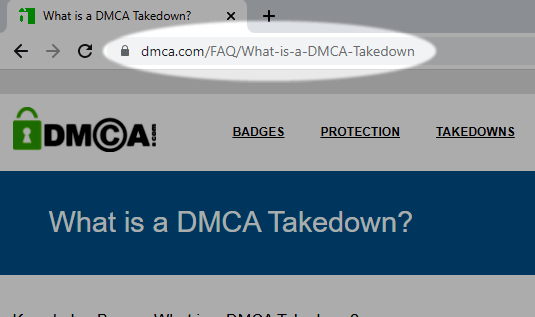
If someone has stolen some or all of your website don't be alarmed, DMCA.com can help get your content removed. It is an all-too-common activity.
At DMCA.com our highly experienced and qualified takedown case staff have been successfully dealing with website theft for years.
To get started right away click here to submit your takedown request: Takedown Form
Why would someone steal my website content?
There are various reasons for the website content theft but besides the obvious, thieves are interested in stealing:
- Your marketing or advertising to "sell" their own content.
- Your design.
- Your website code to sell their own product - saves them the cost of building their own site.
- Your website code to sell YOUR products - this is particularly unscrupulous activity. Thieves will steal your website "lock, stock and barrel" then simply add their own payment gateway. Thieves rake in the sales of your products which they have no intention of sending to your potential clients.
The second worst action is your competition stealing your SEO. Google index is a sensitive issue and many thieves will steal your hard earned website content in order to steal your SEO indexing at your expense.
The most effective method of removing your stolen content from another website is to file a (DMCA) Takedown Notice.
To get started: Submit the Takedown Form
If someone has stolen your content and is publishing it without your permission on another website, DMCA.com can help. Simply submit the name and location of where the stolen content is found and DMCA.com's professional takedown team will go to work on your behalf.
Who is most likely to have their website content stolen?
The two most common commercial DMCA Takedown clients are:
- Bloggers, posters, social media writers, etc. that find their content (pictures or videos) hosted on another website without their permission
- Organizations (corporate and non-profit) that found their content (as listed below) published on another website without their permission. Generally stolen to gain a business advantage, traffic or SEO rankings.
Some examples of stolen content that the takedown team deals with everyday are:
- Pictures
- Videos
- Graphics
- Text
- Games
- Advertising
- Applications
- Programs
- Profiles or Bio's - personal or corporate
- etc...
If these examples describe you, DMCA.com can help.
DMCA.com Fast Tip
If a website uses the DMCA they will usually place a reference in the footer of the website. The clickthrough should clearly state the conditions of the DMCA Takedown process. Many websites reference the DMCA.com Takedown Notice form on this website directly.
Stolen Images and Copyright Infringement
It can be distressing to discover that someone has stolen your website, including its valuable content and images. As a vigilant website owner, you may come across instances where someone steals your website content, duplicating it without permission. Often infringements are found through a reverse image search of your original content. This act of copying content is an infringement upon your intellectual property rights. One way to detect such theft is by monitoring search results. By conducting regular searches using relevant keywords, you can identify unauthorized duplicates of your content that may have surfaced on the web.
Identifying the Theft
To stay informed about potential instances of content theft, website owners can leverage the power of Google Alerts. By setting up alerts using relevant keywords and providing your email address, you will receive notifications whenever your content appears elsewhere online. This proactive approach enables you to detect instances of stolen content at an early stage and take appropriate action promptly.
DMCA.com's Monitoring service can help if someone steals your content. Get started right away and locate your copied content! Sign up here: DMCA.com Monitoring
Take Action!
When faced with the unfortunate scenario of having your website stolen, it is important to take immediate action. Start by collecting evidence of the stolen content, such as screenshots or archived web pages. This evidence will strengthen your case when reporting the infringement. Contact a takedown service provider like DMCA.com for help with takedown. Provide clear evidence of your ownership and emphasize the consequences of copyright infringement.
Copyright Infringement and Legal Measures
If the stolen content is not promptly removed or the website owner does not respond to your request, you may need to escalate the matter legally. Consult with an intellectual property lawyer to understand the best course of action based on your jurisdiction. Copyright laws vary across countries, and legal advice can help you navigate the complexities of enforcing your rights.
DMCA.com Testimonial
Thank you very much for a quick, efficient and effective full takedown. Great communication from Julie, and I'm really pleased with the swift positive result. Thanks again
Who can file for takedown of stolen website content?
- social media users and participants
- content creators/owners
- copyright owners
- content publishers or distributors (with permission of the content or copyright owners)
- NFT owners
- code writers and publishers
- subject contained within the content and published without permission (special considerations may be required)
If the list above does not appear to describe your situation, ask! Click here to Ask about your situation
What is required to takedown stolen website content?
Here are the main points needed to file a Takedown:
Three main pieces of information are needed to get started filing a DMCA Takedown Notice:
1. Infringing URL

Where on the internet is your stolen content located? What is the link that the content should be removed from? Be sure to provide the URL or website/webpage link of the content to be removed. If the stolen content is an image or video located on a website provide the direct link of the content contained in the site. Copy and paste the infringing text, or provide the URL of the infringing image if required.
An example link would look like: https://www.badguy_site.com/webpage/image_2

2. Source URL
Where was your content located when it was stolen? Was it on your social media profile? Was it from your own website? Provide the exact URL where it was stolen from, even if the content has already been removed from its original location. The original URL is still valuable to the notice. If it was not online be sure to reference where it was located when it was stolen such as; cell phone, computer, or camera etc. If it was online such as a website or cloud storage provide the link to the exact page it was stolen from. Alternatively, upload the original content to a cloud storage service and provide that URL with an explanation of where it was originally stolen from.
An example link would look like: https://share.icloud.com/photos/my_original_content
Alternatively, you can use examples like: Computer, Hard Drive, etc.
3. Description of Ownership

What is the content owner's name and how was the content stolen? How is this content yours? Who owns it? Who created it, bought it, or copyrighted it? Who is claiming ownership of the content? Who is authorized to file the DMCA Takedown? When was the content created and when was the content stolen?
An example description would look like: "My photo I took of myself on my camera was stolen from my Google Drive and was posted on this website without my knowledge and I would like it removed."
The Professional Takedown Team at DMCA.com can help with the answers to these questions. Click here to ask about your situation.
Which countries can DMCA takedown stolen website content?
While the DMCA is part of USA Copyright Law. The DMCA Takedown process described within the law is widely used throughout the world. Most countries accept the standard DMCA Takedown Notice form and process. Although the DMCA Takedown is part of US Copyright law, a DMCA Takedown Notice is often used and accepted throughout the world and not exclusive to the United States. However, many countries have their own copyright laws specifically related to the removal of content from internet service providers and site owners within their borders. Which service providers do and do not accept the standard DMCA takedown notice form and process is dynamic and constantly changing. DMCA.com professionals are aware of these constant changes and are able to convert the information submitted through the standard DMCA Takedown signup form to suit specific countries and/or service providers within the legal process they require.
How to add DMCA Protection to a website?
DMCA.com's first recommendation is to contact a lawyer or law firm in the legal jurisdiction of your company or website to determine what is the appropriate legal communication. DMCA.com does not offer any legal advice or specific recommendation regarding any copyright practice.
DMCA.com has two programs to help content creators, publishers and UGC platforms:
- Content Publishers or Platforms of User Generated Content (UGC) should use the DMCA Compliance program - Get Compliant - adding a compliance badge to your site instantly takes the guess work and time out of processing DMCA Takedown notices on your site.
- Content Creators and Publishers (without UGC) should use DMCA.com Protection Pro - Content Protection - it is essential to add an ownership statement to all your content. Registering and adding your content and website to this program is click through easy. There is even a Free program so getting started is easy.
Related DMCA Takedown FAQ's
- What are DMCA Takedowns?
- What is DMCA.com?
- What is DMCA Protection?
- How can I get a webpage removed from Google search results?
- What if I already submitted a DMCA or copyright infringement notice?